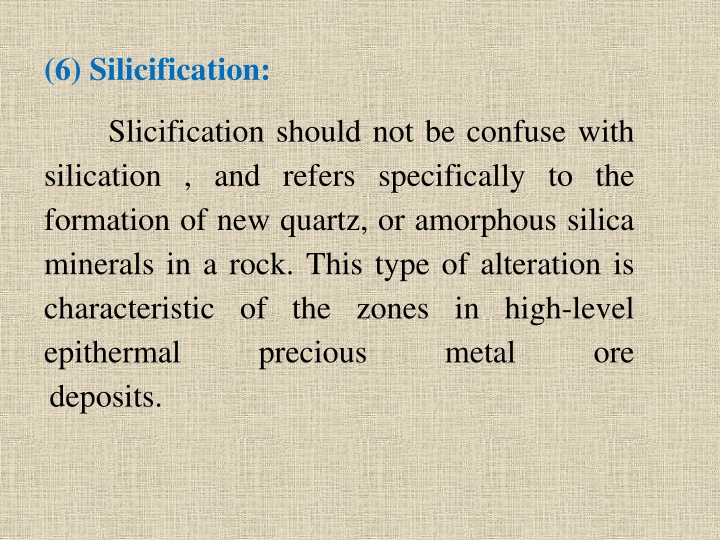
Hydrothermal Ore Deposits and Mineral Alterations
Explore the formation of different types of hydrothermal ore deposits and mineral alterations such as silicification, carbonatization, and hematitization. Learn about epithermal, mesothermal, hypothermal, telethermal, xenothermal, and leptothermal ore deposits along with their unique characteristics and formation conditions.
Download Presentation

Please find below an Image/Link to download the presentation.
The content on the website is provided AS IS for your information and personal use only. It may not be sold, licensed, or shared on other websites without obtaining consent from the author. If you encounter any issues during the download, it is possible that the publisher has removed the file from their server.
You are allowed to download the files provided on this website for personal or commercial use, subject to the condition that they are used lawfully. All files are the property of their respective owners.
The content on the website is provided AS IS for your information and personal use only. It may not be sold, licensed, or shared on other websites without obtaining consent from the author.
E N D
Presentation Transcript
(6) Silicification: Slicification should not be confuse with silication , and refers specifically to the formation of new quartz, or amorphous silica minerals in a rock. This type of alteration is characteristic of the zones in high-level epithermal precious deposits. metal ore
(7) Carbonatization: Carbonatization refers to the formation of carbonate minerals magnesite, siderite, etc.) Related lode-gold deposits represent an ore deposit. (calcite, dolomite,
(8) Hematitization: Alteration that is associated with oxidizing fluids often results in the formation of minerals with a high Fe3+/ Fe2+ratio and, in particular, hematite with associated k-feldspar, sericite, chlorite, and epidote, hydrothermal environment. In the magmatic-
Types of hydrothermal ore-deposits: (a) Epithermal ore-deposits: Formed from solution at a shallow depth below the earth s surface and having a temperature of 50-2000C . (b) Mesothermal ore-deposits: A mineral deposit formed at moderate temperature and pressure, in and along fissures or other openings in rocks, by deposition at intermediate depths. Mesothermal deposits believe to have formed mostly between 1750C and 3000C at depths of (1,220 to 3,660 m).
(c) Hypothermal ore-deposits: Formed at great depths and high temperature (300-5000C). (d) Telethermal deposits: Formed at shallow depth and temperature between 50-2000C. (e) Xenothermal ore-deposits: Formed at high temperature but shallow depth. (f) Leptothermal ore-deposits: Formed from warm waters at rather shallow depth under conditions in the lower ranges of temperature and pressure.
